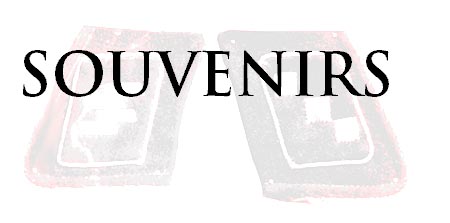 MARK BANDO'S WEBSITE
MARK BANDO'S WEBSITE
The Bulge-At BASTOGNE
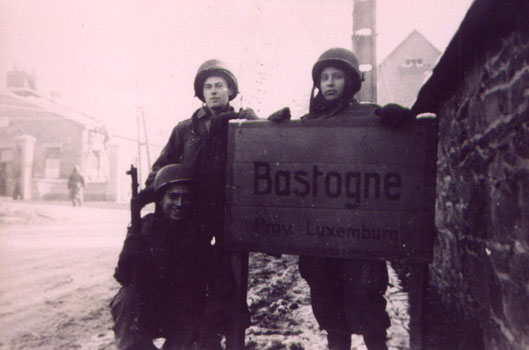
The Battle of Champs
Around 0300 AM on Christmas morning, 1944, the Germans mounted a sizeable infantry attack on the positions of A/502 on the west perimeter of Bastogne at the village of Champs, Belgium. Ouposts, and eventually the MLR were overrun by swarms of German infantry who entered buildings in the village in the confusion of darkness and fog. Lt Jim Robinson, a forward observer for the 377th Artillery was attached to Captain Swanson's A/502 and happened to be in town rather than out on his observation post when the fight started in the wee hours following Christmas Eve. Things looked bad and the issue seemed in doubt, even at dawn. Willis Fowler of A/502 had taken out many of the attackers with his LMG, but fighting to root the Germans out of the houses in town would continue for hours.
Shortly after daylight, Lt Robinson ventured west out of Champs along a two track cart path, headed toward his observation post. He walked over a rise in the ground to a place where bushes grew on both sides of the path. There, huddled down on the path, was a squad of German soldiers, drowsy from their all night vigil, and feeling an apparent sense of security from the cover afforded by the brush on each side of them. These troops were evidently awaiting an order to continue their advance into the town-an order which never came.
Lt Robinson took quick aim with his M-1 rifle, and began shooting the Germans as fast as he could take aim at each individual target. He reloaded with two additional 8 round clips, riddling the prone Germans with a fusilade of 30-06 bullets. He then ran back over the rise and re-entered Champs,
finding one of his enlisted assistant F.O.'s. He tossed the soldier a carbine and yelled "Follow me!"
The duo went over the rise and found a ghastly sight-the Germans were in their death throes and "torrents of blood" were streaming in rivulets through the grooves of the frozen pathway. The assistant F.O. vomited and ran back toward Champs. Lt Robinson stayed to survey the damage he had inflicted. He searched the dead and removed various decorations and badges to retain as souvenirs. 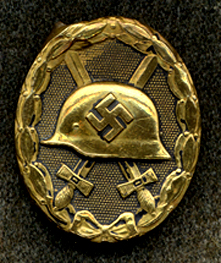
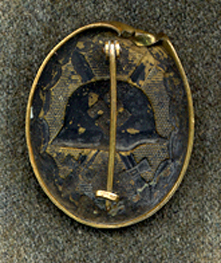 Among them was the black wound badge illustrated above. One of Jim's bullets had nicked the top edge of the badge, as it entered the prone German's body. You will notice the bullet damage is more evident on the back side than the front. Also, most of the black finish has worn off the badge, leaving the brass surface of the badge exposed.
In searching his victims, Jim discovered a box of Christmas cookies which had been sent to one of the unfortunate Germans by his family. The cookies were inside a cowhide flapped backpack. Jim stood there and munched on the cookies as he surveyed his work. "I learned something about myself that day"
he says.
Among them was the black wound badge illustrated above. One of Jim's bullets had nicked the top edge of the badge, as it entered the prone German's body. You will notice the bullet damage is more evident on the back side than the front. Also, most of the black finish has worn off the badge, leaving the brass surface of the badge exposed.
In searching his victims, Jim discovered a box of Christmas cookies which had been sent to one of the unfortunate Germans by his family. The cookies were inside a cowhide flapped backpack. Jim stood there and munched on the cookies as he surveyed his work. "I learned something about myself that day"
he says.
Jim radioed for a barrage of 47 time fire rounds, which burst in the air above the woods where his O.P. as well as some 502 listening posts had been overrun during darkness. Later that morning a stray German Mark IV tank, which had broken through the line to the south near Hemroulle and stayed hidden for hours, made a break for German lines heading through Champs and up the road toward Ruette. Some of the tank riding infantry were picked off before the tank was knocked out by John Ballard with a bazooka. Knowing at last that they were winning decisively, the American troops in the area were cheering when that tank was knocked out.
Later, walking on the main drag in Champs, Jim found the body of one of the tank riding Germans who had been picked-off before Ballard KO'd the tank. It was a soldier named Heinz Werner, who appeared to be about 17 years old. Robinson was impressed by Werner's "youthful, clean appearance, and correct attention to details of his uniform".
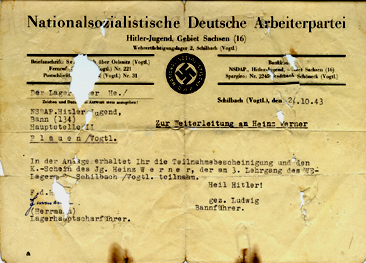 Werner was wearing a short-waisted 2 pocket M44 tunic, and Jim searched the pockets, removing the paper shown above from the left chest pocket. It had been folded twice and an American bullet had passed through the folded paper, making four holes.
The memo was issued by the Nazi Party, and pertains to Werner's prior service in the Hitler Youth.
Werner was wearing a short-waisted 2 pocket M44 tunic, and Jim searched the pockets, removing the paper shown above from the left chest pocket. It had been folded twice and an American bullet had passed through the folded paper, making four holes.
The memo was issued by the Nazi Party, and pertains to Werner's prior service in the Hitler Youth.
 The photo of Lt Robinson shown above, was taken a few months later in the Ruhr Pocket by Lt Red Andrews. Jim received the Silver Star Medal for shooting the Germans along the cart path on Christmas morning. The official writeup says he shot three of them. It was actually many more, but when Captain Swanson asked Jim how many he had shot (in the presence of a bunch of Parachute Infantrymen) Lt Robinson, the artillery observer didn't want to sound boastful, so he said "about three". Johnny Ballard was KIA not long after disabling the MK IV tank with a bazooka.
The photo of Lt Robinson shown above, was taken a few months later in the Ruhr Pocket by Lt Red Andrews. Jim received the Silver Star Medal for shooting the Germans along the cart path on Christmas morning. The official writeup says he shot three of them. It was actually many more, but when Captain Swanson asked Jim how many he had shot (in the presence of a bunch of Parachute Infantrymen) Lt Robinson, the artillery observer didn't want to sound boastful, so he said "about three". Johnny Ballard was KIA not long after disabling the MK IV tank with a bazooka.
MARK BANDO'S WEBSITE
An Unsolved Mystery, Christmas Day, 1944
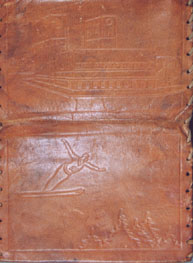 On 25 December, 1944, Company I of the 502 PIR was holding a section of woods in the Bastogne perimeter, facing north in the area west of Recogne, Belgium.
On 25 December, 1944, Company I of the 502 PIR was holding a section of woods in the Bastogne perimeter, facing north in the area west of Recogne, Belgium.
Bob Tripp and another trooper were on outposts in front of the main line defenses, when they observed two German scouts moving toward them. The scouts were spaced over 100 yards apart. One would pass close to Tripp's place of concealment and the other was headed toward the other Item Co. outpost. Tripp contacted the trooper on the other outpost via radio and said "When you hear me shoot the Kraut closest to me, take out the guy closer to you."
Tripp did shoot the German who walked near his position, killing him with one round. He heard the other trooper fire, but "he got buck fever and missed his man." The other German ran away, escaping back to his lines.
Tripp dragged his victim into his hole and searched him. The dead man's pockets were basically empty. He was carrying a wallet, but had left his Soldbuch in the rear, as was standard procedure for German troops going into enemy lines. If the victim was wearing a dogtag (identity disc), Tripp did not observe it. Inside the wallet, Tripp found the name 'Herbert Runte' printed on the leather. The outer face of the wallet has an impressed image of a ski jumper, suggesting that the victim (owner) may have been in one of the German units that was sent to the Ardennes offensive from occupation duty in Norway.
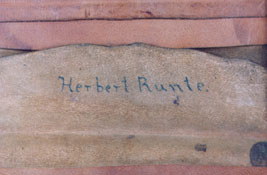 Tripp kept the wallet for his own use and later printed his own name on a different part of the leather. He also wrote the date he had acquired the wallet:'12-25-44'.
Tripp kept the wallet for his own use and later printed his own name on a different part of the leather. He also wrote the date he had acquired the wallet:'12-25-44'.
When I acquired the wallet for my collection from Bob Tripp several years ago, I checked for any KIAs named Herbert Runte on the German War Graves Commission's website.
The only match I found was for a sailor in the German Navy who died in April of 1945. There seem to be several possible explanations for this.
One possibility is that the wallet did once belong to the sailor named Herbert Runte but that a German Army soldier later took possession of it and never bothered to remove Runte's name from the wallet.
Another possibility is that the soldier killed by Tripp that day was a German Army man also named Herbert Runte, and that his body was never found. This is quite possible as Tripp and his friends later buried the man's body in front of the woods where Item 502 had their main line. A rifle with bayonet was stuck in the ground near the grave, to mark the spot. But it's quite possible that the rifle was removed before Graves Registration ever located or recovered the body. If that is what happened, and if the dead man's name was indeed Herbert Runte, it is possible that he is still listed as Vermisst (mising in action) on the German casualty rolls. I have no way of checking that, but perhaps some visitors to this website can determine if a Herbert Runte in the German Army went permanently MIA on 25 December, 1944? If so, part of the mystery is solved. Only the remains need to be recovered. But-it is also possible that the body was found, minus any identification and is buried as an 'unbekannt Deutscher Soldat' (unknown German soldier).
Optics Courtesy Panzer Lehr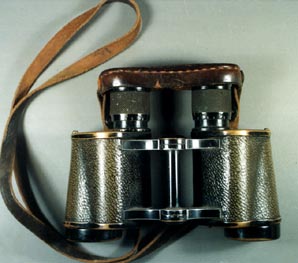 Another abortive Christmas morning attack was halted SE of Bastogne at the village of Marvie. Don
Peterson of B/326th AEB liberated these 6x30 binoculars from the dead commander of a Mark IV Panzer knocked out east of Marvie.
The tank was probably a member of the 130 Panzer Lehr regiment.
Another abortive Christmas morning attack was halted SE of Bastogne at the village of Marvie. Don
Peterson of B/326th AEB liberated these 6x30 binoculars from the dead commander of a Mark IV Panzer knocked out east of Marvie.
The tank was probably a member of the 130 Panzer Lehr regiment.
From a Fallen Panzer Corporal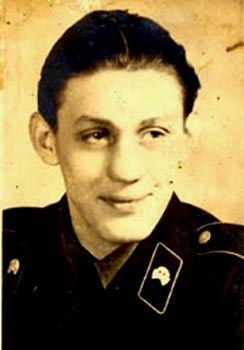 German Army Panzer corporal Richard Durig was born 2 January, 1925 at Thum, Germany. He entered the military on 18 September, 1942 and received the tank battle badge on 18 August, 1943, for fighting with the 33rd regiment of the 9th Panzer Division . He survived the largest tank battle in history at Kursk, but was hospitalized for nervous/mental disorders in January of 1944.
German Army Panzer corporal Richard Durig was born 2 January, 1925 at Thum, Germany. He entered the military on 18 September, 1942 and received the tank battle badge on 18 August, 1943, for fighting with the 33rd regiment of the 9th Panzer Division . He survived the largest tank battle in history at Kursk, but was hospitalized for nervous/mental disorders in January of 1944.
Re assigned to the Panzer Grenadier training & replacement battalion 2, he fought in Normandy and received the wound badge in Black on 18 August, 1944, exactly a year after award of the tank badge.
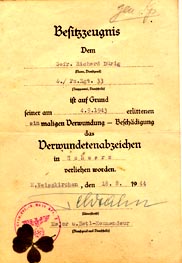 The image above shows Durig's wound badge document, as well as an actual four-leaf clover, which is still with Durig's papers some 60 years later.
The image above shows Durig's wound badge document, as well as an actual four-leaf clover, which is still with Durig's papers some 60 years later.
Art Parker, a survey and instrument man for HQ/377th provided the webmaster with Durig's papers about 15 years ago. According to dogtag info from the German War Graves Comission,
the remains of a soldier with the Soldbuch number and dogtag info for Richard Durig, were recovered in the Bastogne area of Belgium in February, 1945. Death probably occured a month earlier, during the numerous attacks by German panzer forces against the 101st bastion.
At the time, Durig was serving with the 2d Panzer Grenadier Regiment of the 2nd Panzer Division. He probably fell on the north perimeter, near Foy or Noville. The remains are buried in a German military cemetery at Hamm, Luxembourg.
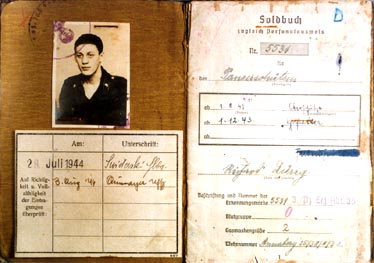
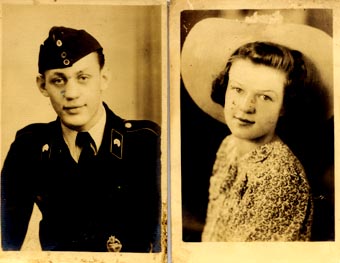 Above is another studio portrait of Durig found in his Soldbuch, showing his black Panzer uniform. There is also a photo of a girl, presumably his girlfriend. Also in the back cover of his Soldbuch, was his folded Besitzzeugness (eligibility certificate) for the wound badge, the four leaf clover, and 2 newspaper clippings which were death notices of Durig's friend, Heinz Gaussmann, who had been killed in January, 1942, on the eastern front.
Above is another studio portrait of Durig found in his Soldbuch, showing his black Panzer uniform. There is also a photo of a girl, presumably his girlfriend. Also in the back cover of his Soldbuch, was his folded Besitzzeugness (eligibility certificate) for the wound badge, the four leaf clover, and 2 newspaper clippings which were death notices of Durig's friend, Heinz Gaussmann, who had been killed in January, 1942, on the eastern front.
Art Parker hit two German tanks with bazooka fire in one day, in the area of Koevering, Holland in September, 1944. Pretty good work for a survey and instrument man-but because of his artillery MOS, Art was ineligible to receive the Combat Infantryman Badge.
Volksgrenadier Camouflage Garments
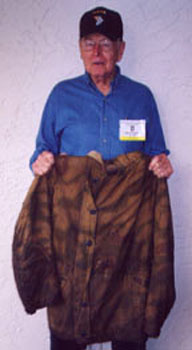
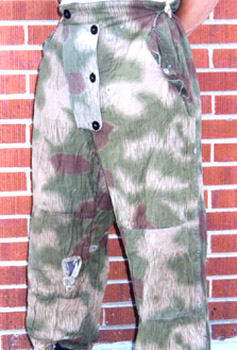 The 2005 photo at upper left, shows former 501st medic Bill France holding a water pattern German camouflaged jacket. Bill removed this from a wounded German in the Bois Jacques forest NE of Bastogne, in January of 1945. He pulled the garment off a wounded prisoner, who was lying on a stretcher on a jeep, awaiting evacuation. Bill put the garment on and wore it with his red cross brassard on the arm and surmounted by his GI steel pot. Less than 24 hours later, an officer ordered Bill to remove the jacket. So he mailed it home and put it in a trunk until it joined the webmaster's collection at Snowbird of 2005. As the garment has never been laundered since leaving combat it is still heavily soiled, bloodstained and greasy, all remnants from its time in the Battle of the Bulge.
The 2005 photo at upper left, shows former 501st medic Bill France holding a water pattern German camouflaged jacket. Bill removed this from a wounded German in the Bois Jacques forest NE of Bastogne, in January of 1945. He pulled the garment off a wounded prisoner, who was lying on a stretcher on a jeep, awaiting evacuation. Bill put the garment on and wore it with his red cross brassard on the arm and surmounted by his GI steel pot. Less than 24 hours later, an officer ordered Bill to remove the jacket. So he mailed it home and put it in a trunk until it joined the webmaster's collection at Snowbird of 2005. As the garment has never been laundered since leaving combat it is still heavily soiled, bloodstained and greasy, all remnants from its time in the Battle of the Bulge.
This hooded jacket has a shiny grey lining and is non-reversible.
E/501st 2d platoon medic Anacleto Leone removed the padded, reversible camo to white winter trousers pictured above right, from a dead German near Bizory, Belgium in December, 1944. This was in the eastern Bastogne perimeter and the deceased soldier was probably a member of the 26th Volksgrenadier Division.
Cleto lifted the man's legs and removed the trousers which have 1/2 dozen small shell fragment holes and at the time were heavily bloodstained. The German had been wearing them with the the white side exposed. The photo above shows the tan water pattern camo, (typical of late war German Army camo garments), exposed.
Cleto mailed the pants home at the end of the Bastogne campaign, but before he returned from overseas, his mom washed all the blood out of the pants. This made Cleto upset, because he wanted the trousers mainly for that reason. He did wear them on the Rouge Park toboggan slides in Detroit after WW2, and can attest that they are very warm. These were added to the webmaster's collection in August of 2002.
Significant Scrap Metal
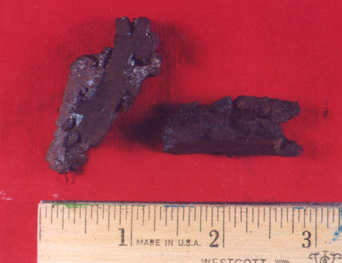 Captain Joe Pangerl was summoned to a meeting on Christmas Eve, 1944, while stationed at the Rolle castle, NW of Bastogne, Belgium. During the meeting, the officers could hear close artillery rounds impacting in the area. After the meeting, Pangerl went to his quarters and discovered that a German artillery shell had hit the roof and sent steel shrapnel flying into the room at high velocity.
Captain Joe Pangerl was summoned to a meeting on Christmas Eve, 1944, while stationed at the Rolle castle, NW of Bastogne, Belgium. During the meeting, the officers could hear close artillery rounds impacting in the area. After the meeting, Pangerl went to his quarters and discovered that a German artillery shell had hit the roof and sent steel shrapnel flying into the room at high velocity.
Joe found six holes in his sleeping bag, made by
various shell splinters, two of which are shown above. The holes were in places where his head and torso would've been, had he been in the bag when that shell hit.
The fragments above weigh 31 grams (1.1 oz) and 18 grams (.6 oz), and have substantial weight, for their size. They are thick and heavy.
The pieces above were recently added to the webmaster's collection. Items like this are routinely tossed in the trash by veterans' relatives after the vets pass away, because they seem to have absolutely no significance nor value to the families without the story behind them. That is why it is important to document these things while it can still be done.
The red ripcord handle from Hank Gogola's reserve chute for the Holland jump is another example. Hank kept it as a souvenir because his main chute streamered and when he pulled his reserve, it opened when he was only 60'above the ground. I tried to get that item from Hank before he died, but to no avail. Who knows where it is now?
Without the story, that is just another reserve chute handle and to uninformed relatives, probably just a piece of meaningless junk, to be discarded.
Kraut Propaganda
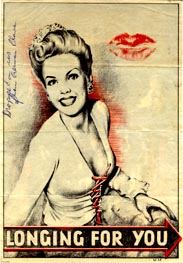
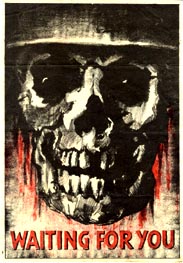 German propaganda leaflets were air-dropped or sent by rifle grenade canister, to float down over American lines. Unlike American leaflets, which merely told of the hopelessness of the German cause by citing statistics or testimony from Germans in captivity, the German leaflets targeted the worst fears of the GIs. Usually illustrated with provocative cartoons, the German leaflets carried diabolical messages playing on the fear that a soldier would not survive to see his wife and/or children again. Other big fears were being maimed or crippled, and that the wife was cheating with another man. Above is a type of leaflet shot over U.S. lines at Bastogne, Dec. '44.
German propaganda leaflets were air-dropped or sent by rifle grenade canister, to float down over American lines. Unlike American leaflets, which merely told of the hopelessness of the German cause by citing statistics or testimony from Germans in captivity, the German leaflets targeted the worst fears of the GIs. Usually illustrated with provocative cartoons, the German leaflets carried diabolical messages playing on the fear that a soldier would not survive to see his wife and/or children again. Other big fears were being maimed or crippled, and that the wife was cheating with another man. Above is a type of leaflet shot over U.S. lines at Bastogne, Dec. '44.
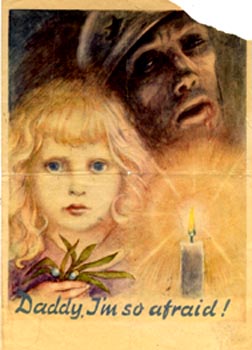
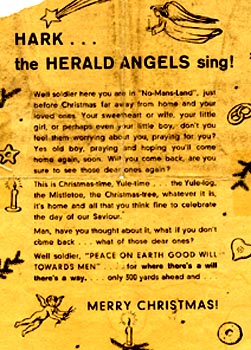 From George Schulist comes this, the most famous of all
leaflets dropped on the 101st at Bastogne. The text of this type was read in the movie Battleground (1950).
From George Schulist comes this, the most famous of all
leaflets dropped on the 101st at Bastogne. The text of this type was read in the movie Battleground (1950).
Souvenirs from Foy
Collar Corner from fallen SS Sgt Near FOY
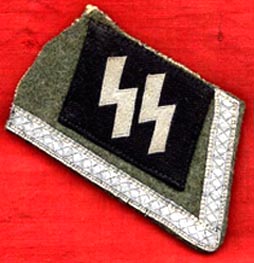 This collar corner was cut from the corpse of an SS sergeant in the woods near Foy, Belgium in January, 1945. Wilson Boback of G/501 recalls that the man was "frozen like a popsicle" (stiff from the cold weather). At the time, troops of the 501 and 506th were engaged with Panzergrenadiers of the 26th Regiment of the 12th SS 'Hitlerjugend' Division. Judging from the clean and new appearance of this item, this SS tunic must have been newly-issued to the unfortunate SS Sgt, at the start of the Ardennes Offensive.
This collar corner was cut from the corpse of an SS sergeant in the woods near Foy, Belgium in January, 1945. Wilson Boback of G/501 recalls that the man was "frozen like a popsicle" (stiff from the cold weather). At the time, troops of the 501 and 506th were engaged with Panzergrenadiers of the 26th Regiment of the 12th SS 'Hitlerjugend' Division. Judging from the clean and new appearance of this item, this SS tunic must have been newly-issued to the unfortunate SS Sgt, at the start of the Ardennes Offensive.
MARK BANDO'S Trigger Time WEBSITE
SS M43 FIELD CAP INSIGNIA
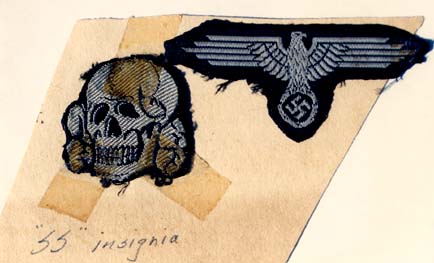 Also while processing POWs at Bastogne, Paul Teator of the 101st MP Platoon removed this cloth eagle and skull from the front of a Waffen SS prisoner's M43 forage cap. The insignia are shown as mounted in Teator's personal war album.
Also while processing POWs at Bastogne, Paul Teator of the 101st MP Platoon removed this cloth eagle and skull from the front of a Waffen SS prisoner's M43 forage cap. The insignia are shown as mounted in Teator's personal war album.
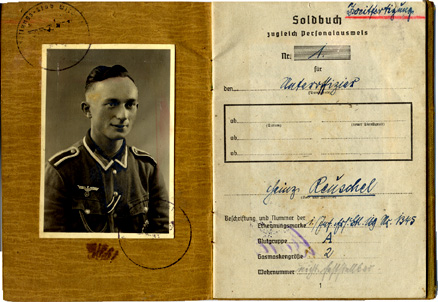 This German Army Sergeant's Soldbuch was found lying in the snow outside Bastogne in late December, 1944. Bill Tofant, of the 101st C.I.C.(Counter-Intelligence Corps) detachment picked it up
as a souvenir. The notation underlined in red at the top right indicates that this book was a replacement, issued because the original book was too worn-out to be serviceable. This 'Unteroffizier' had fought in Russia and had received the Infantry Assault Badge and Iron Cross 2nd class in late 1941.
His current unit was Grenadier Regiment 959, part of the 363rd Volksgrenadier Division of the 15th Army. Much of this unit was rebuilt from survivors of wiped out German units such as the 352nd Grenadier Rgt and 336th Inf. Rgt.(183rd and 161st Divisions). There is no listing of the owner's previous units in this replacement Soldbuch, and his fate in the Bulge is unknown. The 959th Rgt was believed to be in reserve during the Ardennes Offensive, and the book was found in the area of the Fifth Panzer Army. It may have been 'planted' to mislead Allied
intelligence. c/o Bill Tofant.
This German Army Sergeant's Soldbuch was found lying in the snow outside Bastogne in late December, 1944. Bill Tofant, of the 101st C.I.C.(Counter-Intelligence Corps) detachment picked it up
as a souvenir. The notation underlined in red at the top right indicates that this book was a replacement, issued because the original book was too worn-out to be serviceable. This 'Unteroffizier' had fought in Russia and had received the Infantry Assault Badge and Iron Cross 2nd class in late 1941.
His current unit was Grenadier Regiment 959, part of the 363rd Volksgrenadier Division of the 15th Army. Much of this unit was rebuilt from survivors of wiped out German units such as the 352nd Grenadier Rgt and 336th Inf. Rgt.(183rd and 161st Divisions). There is no listing of the owner's previous units in this replacement Soldbuch, and his fate in the Bulge is unknown. The 959th Rgt was believed to be in reserve during the Ardennes Offensive, and the book was found in the area of the Fifth Panzer Army. It may have been 'planted' to mislead Allied
intelligence. c/o Bill Tofant.
German Dogtag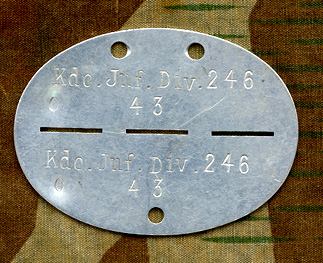 In late 1944, Paul Teator left 101st divisional G-3 to become a member of the division's M.P. platoon. At Bastogne, he processed many German prisoners. During that time, Paul acquired the German dogtag shown above, designated to Soldbuch # 43 in the 246th Infantry Division, part of the 5th Panzer Army, which was part of the south prong of the Ardennes offensive. The 246th Infantry Division had existed since 1939, but was reconstituted as a Volksgrenadier Division in September, 1944.
In late 1944, Paul Teator left 101st divisional G-3 to become a member of the division's M.P. platoon. At Bastogne, he processed many German prisoners. During that time, Paul acquired the German dogtag shown above, designated to Soldbuch # 43 in the 246th Infantry Division, part of the 5th Panzer Army, which was part of the south prong of the Ardennes offensive. The 246th Infantry Division had existed since 1939, but was reconstituted as a Volksgrenadier Division in September, 1944.
An unopened Christmas Present
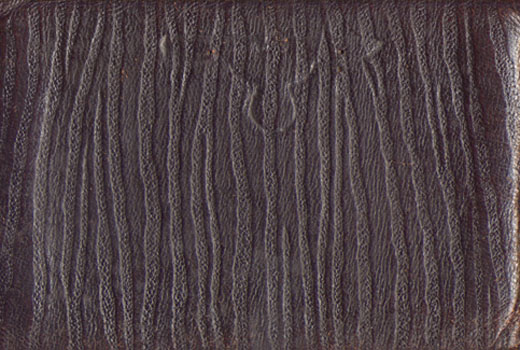 Sgt Reginald Davies of the HQ/2 502 LMG platoon, organized the gun teams in his section to support Dog Co. of the Deuce in the Longchamps/Monaville, Belgium sector. They engaged in a heated action on 3 January, 1945, with elements of the 9th SS Panzer Division 'Hohenstauffen'.
Sgt Reginald Davies of the HQ/2 502 LMG platoon, organized the gun teams in his section to support Dog Co. of the Deuce in the Longchamps/Monaville, Belgium sector. They engaged in a heated action on 3 January, 1945, with elements of the 9th SS Panzer Division 'Hohenstauffen'.
After the battle, Reg searched the body of a fallen panzer grenadier, who was lying in the snow near a burning German tank. One of the items in the dead German's pack, was an unopened Christmas present, still in its bright, colored wrapping paper. Reg opened the present and discovered it to contain a typical, large German wallet of the type used to hold a paybook (Soldbuch). The book was made of sturdy brown leather pigskin and of couse was in new condition. Pinned to the outside of the wallet was a metal SS cap eagle. The wallet is pictured above and the distinctive outline of the SS style eagle and 2 pin holes can still be clearly seen in the leather.
The family of the deceased German had sent this to him at the front and had affixed the eagle, which was since removed by Reg's children after WW2. The family had also tucked some paper money into one compartment of the wallet. The soldier had died before getting the opportunity to place his Soldbuch into the wallet.
The original owner of the wallet was almost certainly a member of the 19th SS Panzer Grenadier Regiment, of the 9th SS Panzer Division. The wallet, still in pristine condition, was added to the webmaster's collection in September of 2005.
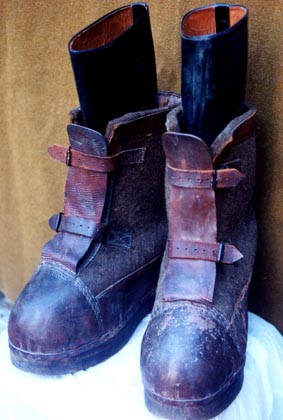 Some WW2 GIs chose pretty bizzare souvenirs to bring home.
It makes one wonder why they would make the effort to lug home something with the bulk and weight of these boots. They are German Army issue Winter Sentry Boots, featuring soles of solid wood, about 2" thick. These were worn completely over regular
boots and the crude felt flaps (similar to carpet padding) were
secured around the ankles with twin leather buckle straps. The black jackboots were inserted here to demonstrate how they fit
inside. Sgt Tom Enright of F/501 brought these back in 1945-I guess their value as a conversation piece justified the effort involved in carrying them home
Some WW2 GIs chose pretty bizzare souvenirs to bring home.
It makes one wonder why they would make the effort to lug home something with the bulk and weight of these boots. They are German Army issue Winter Sentry Boots, featuring soles of solid wood, about 2" thick. These were worn completely over regular
boots and the crude felt flaps (similar to carpet padding) were
secured around the ankles with twin leather buckle straps. The black jackboots were inserted here to demonstrate how they fit
inside. Sgt Tom Enright of F/501 brought these back in 1945-I guess their value as a conversation piece justified the effort involved in carrying them home
Bois Jacques Bullet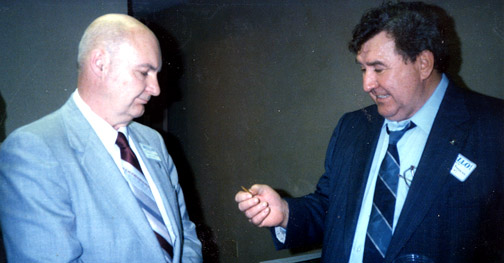 I took the photo above about 15 years ago. Russell "Bud" Layton, of A/501 stands at left, while Jim Nadeau (F/501)at right, examines a deformed 7.92 slug from an MG42, which narrowly missed killing Layton on 21 December, 1944.
I took the photo above about 15 years ago. Russell "Bud" Layton, of A/501 stands at left, while Jim Nadeau (F/501)at right, examines a deformed 7.92 slug from an MG42, which narrowly missed killing Layton on 21 December, 1944.
Layton had joined the 501 as a replacement at Camp Mourmelon, France shortly before the Battle of the Bulge. His company along with Dog Company, was sent north into the Bois Jacques Woods, soon after arriving at Bastogne. They had a spooky battle in the fog along the railroad embankment, but prevented any large German forces from approaching Bastogne along that route. S.L.A. Marshall later wrote that the Germans missed their greatest opportunity to get armor into Bastogne, by not concentrating on the approach offered by that railroad line during the period of 18-21 December. The other companies of 1st and 2nd battalions of the 501 were anchored around Bizory-Neffe for the next two weeks.
On 21 December, Bud was crawling through the woods toward a German MG nest, when he was spotted by the enemy gunner. When Bud saw bullets beating the snowy ground, coming in his direction, he rolled behind a pine tree. A bullet went through the tree trunk, struck his suspender 'D' ring,
and made a painful bruise on his left chest. The German gunner thought he had inflicted a serious hit on Bud, and turned his attention elsewhere. Bud waited awhile, then crept up and grenaded the nest, finishing the crew with his M-1.
The next day, Bud found the deformed slug which had almost killed him in the left chest pocket of his M43 field jacket. Bud was seriously wounded and evacuated on 27 December, 1944, but managed to keep the slug as a souvenir. He turned 79 on 28 June, 2004, and enjoys excellent health.
Another Kind of Souvenir
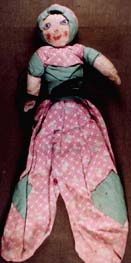
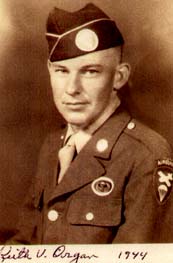
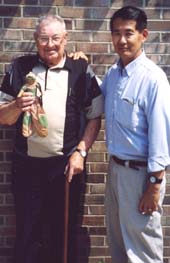 Paratrooper Keith Organ joined E company 502 PIR, as a replacement at Camp Mourmelon, France in late 1944. He fought in the battles north of Bastogne, between Longchamps-Monaville, Belgium, until seriously wounded by fire from a StuG IV on 3 January, 1945.
Paratrooper Keith Organ joined E company 502 PIR, as a replacement at Camp Mourmelon, France in late 1944. He fought in the battles north of Bastogne, between Longchamps-Monaville, Belgium, until seriously wounded by fire from a StuG IV on 3 January, 1945.
Keith was medically evacuated to Paris, then sent to an English hospital at an unknown town in the UK.
One afternoon, while Keith was in this hospital, a young English girl, perhaps 12 years old, entered his ward, bearing handmade gifts. She had several cloth dolls, which she had hand-sewn and added a drawn face and braided black thread hair.
The doll's legs are hollow, with pockets, to hold cigarettes or a toothbrush. She walked through the ward and tied one doll to each of several beds that had a pullup bar. Keith Organ's bar was one of the recipients. When Keith was discharged from the hospital, he brought this doll home, his only souvenir of the war in Europe.
It's a shame that we don't know the girl's identity, or the name of the town where this took place. The photos above, show Keith's doll and Keith with the webmaster, in 2003.
Battle of Bastogne 'Nuts' Plaques
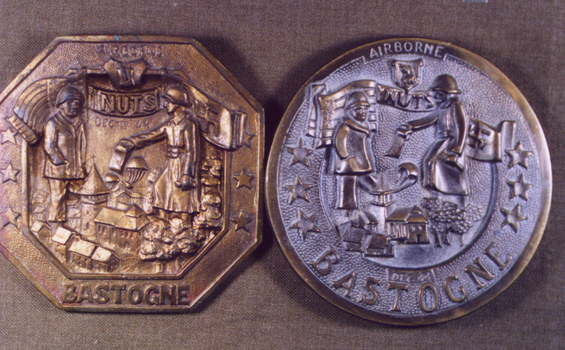 There are at least two common versions of this souvenir-a brass plaque remembering General McAuliffe's reply to the Nazi surrender demand on 22 December, 1944. These items are made from melted-down artillery brass casings of which there were a great surplus in the Ardennes, following the Battle of the Bulge. Although I've seen both the octagonal (8-sided) and round plaques in the hands of vets from all regiments and battalions of the WWII 101st Airborne, some Deuce vets claimed they were 'awarded' the 8-sided versions, in a postwar ceremony, during occupation duties in Austria. I cannot verify if this allegation is true.
There are at least two common versions of this souvenir-a brass plaque remembering General McAuliffe's reply to the Nazi surrender demand on 22 December, 1944. These items are made from melted-down artillery brass casings of which there were a great surplus in the Ardennes, following the Battle of the Bulge. Although I've seen both the octagonal (8-sided) and round plaques in the hands of vets from all regiments and battalions of the WWII 101st Airborne, some Deuce vets claimed they were 'awarded' the 8-sided versions, in a postwar ceremony, during occupation duties in Austria. I cannot verify if this allegation is true.
Aside from the award allegation, I've been told that these plaques were sold in souvenir shops in Belgium for many years after WW2 ended. So not all of the ones in existence were ever owned by 101st veterans. However I can state that these plaques are almost universally found in the personal effects of WWII 101st veterans.
When I first started visiting 101st vets in their homes in 1968, I saw many of these plaques lying flat on a kitchen or livingroom table, being used as ashtrays, by the vets themselves. Only seldom have I seen them actually hung on a wall, and then usually they were framed in a shadowbox. So much for respect or decorum...
These plaques usually still change hands for under $100- U.S., because many people do not know the significance of them. They also probably don't know for sure if any 101st soldiers ever actually 'owned' these items-the answer is yes.
One final note:
The octagonal version is unmarked, but the round versions are marked "Couvin Belgium" on the reverse.
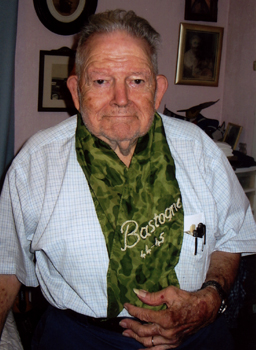 Don Ginter served in HQ Battery, 377th PFAB at Savy, Belgium, during
the battle of Bastogne. Here he wears a souvenir scarf, consisting of a piece of camouflaged parachute canopy
with the wording:
Don Ginter served in HQ Battery, 377th PFAB at Savy, Belgium, during
the battle of Bastogne. Here he wears a souvenir scarf, consisting of a piece of camouflaged parachute canopy
with the wording:
'BASTOGNE
44-45'
embroidered on it. Don does not recall where he acquired this item, but the chain
stitching is characteristic of lettering done in Europe.



































